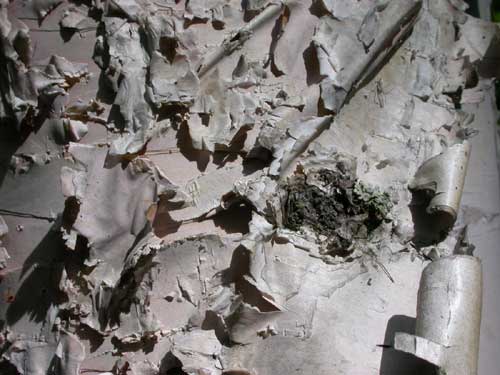 Pollen season arrives; blame
the trees
Pollen season arrives; blame
the trees
By Ned Rozell
May 06, 2008
Tuesday PM
With your next breath of spring air, you'll pull dozens of invaders
through your nose. These intruders may make your nose drip and
your eyes red and watery.
The airborne invaders are grains of tree pollen, specks so small
that it would take eight of them to cover the period at the end
of this sentence. The air is rich with pollen because spring
is the mating season for trees.
The first step in a tree's reproductive dance is to release sperm,
safely held in the center of a pollen grain. Trees release an
incredible amount of pollen to improve the odds of finding a
female flower. One birch catkin (the cluster of tiny flowers
that looks like a caterpillar) can release millions of pollen
grains.
 The bark of a birch
tree that is now releasing millions of grains of pollen.
The bark of a birch
tree that is now releasing millions of grains of pollen.
Photo by Ned Rozell
Birch is the worst of the Alaska pollen types for allergy sufferers,
said the late Jim Anderson, former biosciences librarian for
the University of Alaska Fairbanks. In addition to being a collector
of neckties, teddy bears, typewriters, and other things, Anderson
had a passion for pollen. He studied it for years with an air-sniffing
instrument mounted on top of a building. Looking at years of
data, he found a few trends in the way trees and other plants
release pollen.
Anderson found that birch trees begin releasing pollen about
two days before leaves emerge from buds, and the concentration
of birch pollen is greatest about three days after the leaves
come out. He measured more than 4,500 grains of birch pollen
per cubic meter on the highest pollen days.
Allergy sufferers are hit hardest by birch pollen because it
contains irritating proteins. Each grain of pollen consists of
a center containing the male genetic material, surrounded by
a protective wall called the exine (which was the word on Anderson's
vanity license plate). When pollen comes in contact with moisture,
such as that on the nose's mucous membranes or the lining of
the eyelid, protein molecules from the exine leach into a person's
tissues. An allergic person's immune system produces antibodies
against the protein molecules. Antibodies then trigger the release
of histamines and other potent substances, leading to the cold-like
symptoms familiar to allergy sufferers.
Anderson discovered that watching the weather could help him
predict the day trees release pollen. By taking the average of
the daily high and low temperatures and subtracting 32 degrees
Fahrenheit, he came up with a number called degree-days. By looking
at past years' pollen outbreaks and comparing them with temperature
records, he found that, in the Fairbanks area, poplar and aspen
release pollen first. Next come birch, alder, spruce and grasses,
all at specific numbers of degree-days.
Though the dates of pollen release from year to year vary with
the warmth of spring, Anderson said he was able to keep a running
tally of degree-days. He knew, for example, that when the number
approaches 232, birch trees are ready to release pollen. He also
found that birch trees tend to release pollen in greater amounts
every other year. He didn't know the reason for the biennial
cycle, but thought it had to do with the biological makeup of
birches.
Luckily for those with allergies, pollen season doesn't last
very long. According to pollen calendars Anderson has made for
Fairbanks and Anchorage, birch trees typically shed large amounts
of pollen May 10th through the 20th.
This column is provided
as a public service by the Geophysical Institute,
University of Alaska Fairbanks, in cooperation with the UAF research
community. Ned Rozell is a science writer at the institute.
E-mail your news &
photos to editor@sitnews.us
Publish A Letter in SitNews Read Letters/Opinions
Contact the Editor
SitNews
©2008
Stories In The News
Ketchikan, Alaska
|



